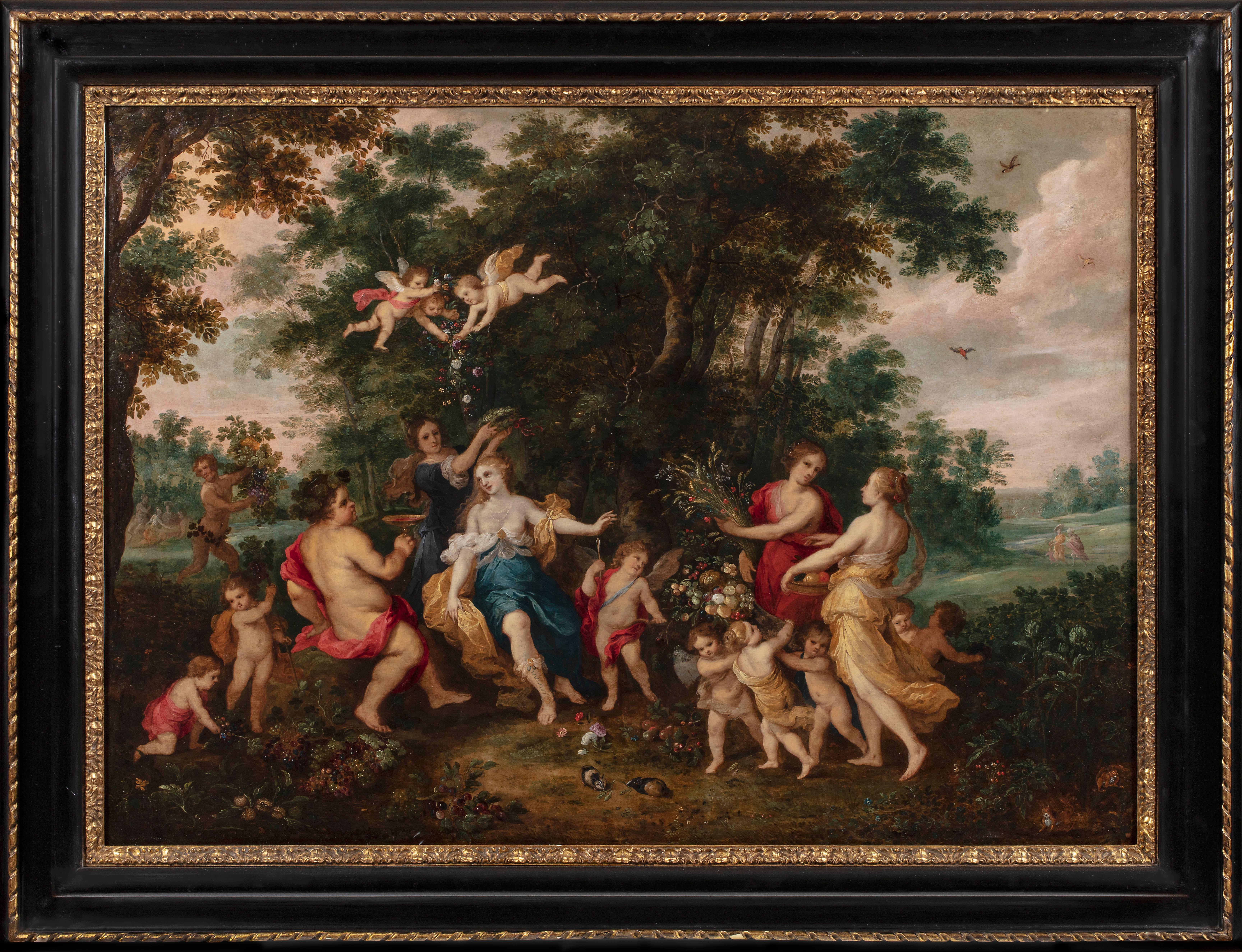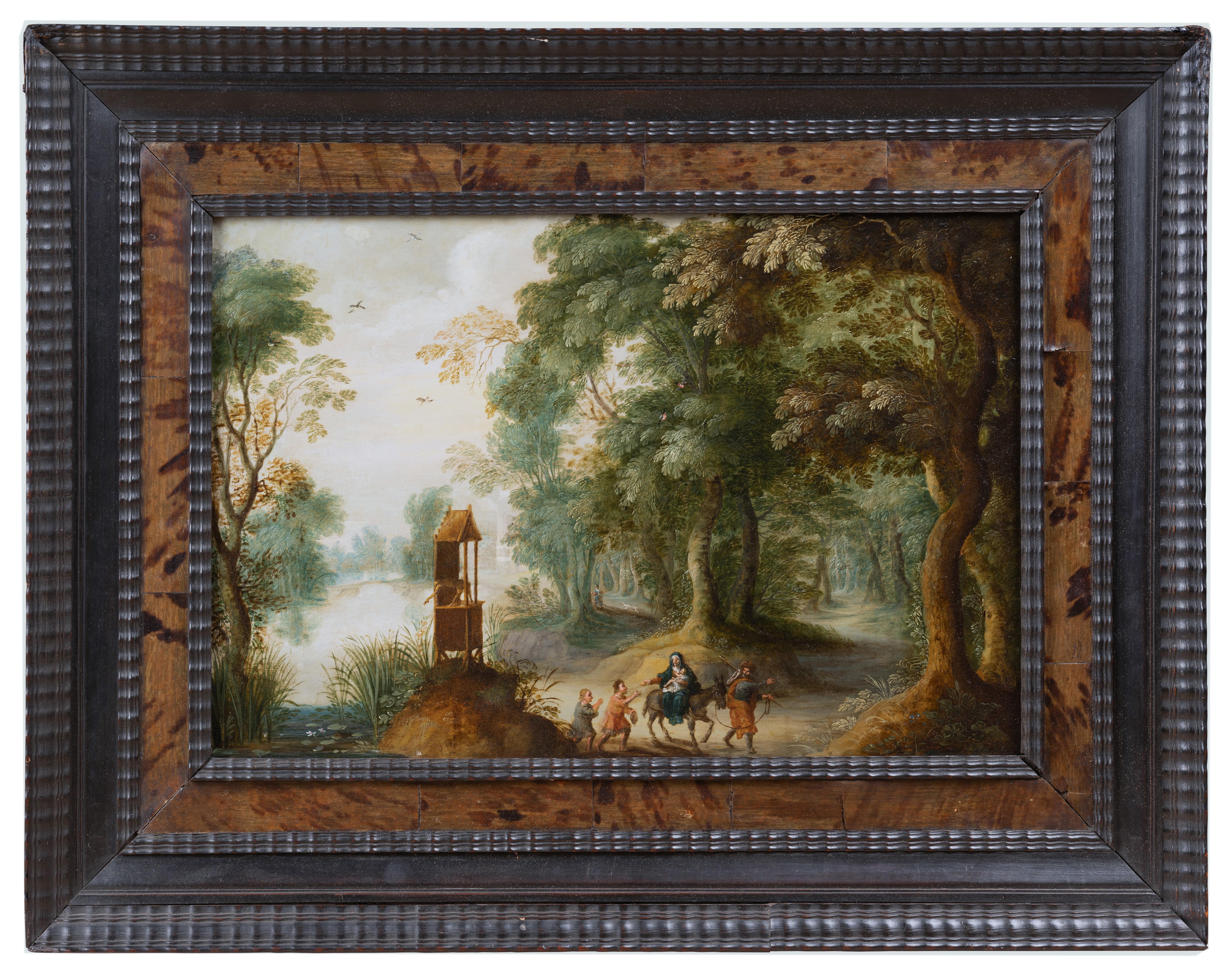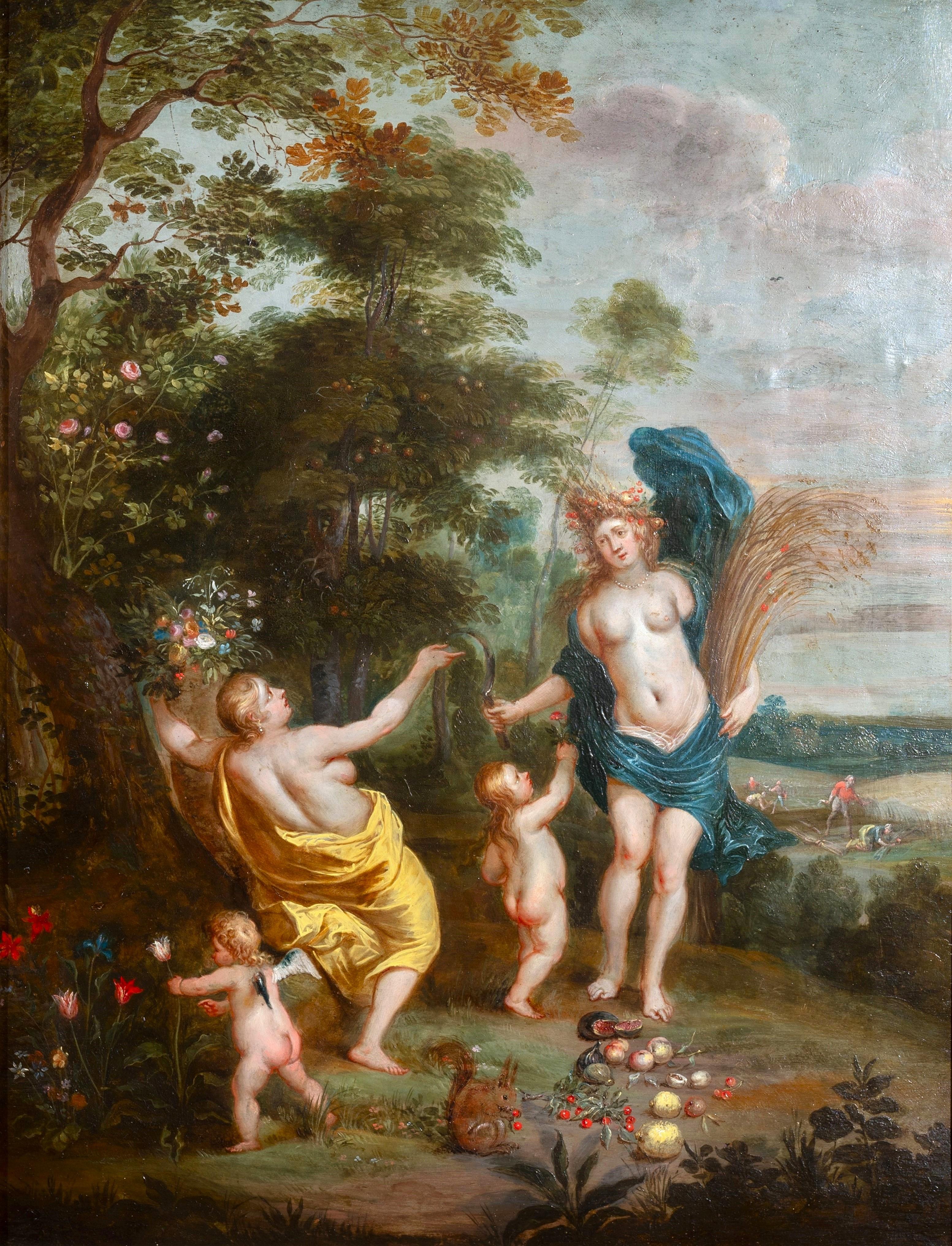Items Similar to River Landscape with Shepherds and Architecture, a painting by Jan van Bunnik
Want more images or videos?
Request additional images or videos from the seller
1 of 9
Jan van BunnikRiver Landscape with Shepherds and Architecture, a painting by Jan van BunnikLate 17th century
Late 17th century
About the Item
This painting has been the subject of a study by the art historian Fabrizio Dassie (available on request), confirming its inclusion in Jan van Bunnik’s corpus.
In this painting, Jan van Bunnik presents us with an Italian-inspired landscape. Executed with extreme meticulousness, it displays a vast horizon despite the small size of the copper. The double rainbow in the distance also evokes the Flemish landscape tradition.
1. Jan van Bunnik, a Dutch painter in Rome
Born in Utrecht in 1654, from 1668 for a period of three years, Jan van Bunnik (whose family name is also sometimes written van Bunnick) was a pupil of Herman Safleven (1632 - 1685), who had a lasting influence on his work. He then moved to the Duchy of Kleve where he met the painter Gerard Hoet (1648 - 1733) who is said to have convinced him to go to Rome. Once in Rome, he was welcomed by the Nederlandsche Schildersbent (the “painters’ band” an informal association of Netherlandish painters active in Rome during the 17th century). While developing a very personal style, he was obviously influenced by the other Flemish and Dutch landscape painters then present in Rome. He also benefited from the advice of Carlo Maratta, who encouraged him to explore Italianate landscapes.
He then prolonged his stay in Italy, going back and forth between Rome and other artistic centres (Naples, Bologna, Ferrara, Venice, Modena, where he stayed for eight years at the court of Duke Francis II of Este), before returning to Utrecht for the end of his life, after a long journey through France.
Celebrated in the 18th century, he had gradually fallen into oblivion until art historians set out to reconstruct his corpus, separating his artworks from those of Alessandro Grevenbroek (who died in 1748) with whom they were often confused.
2. Description of the artwork
This painting is typical of the fusion between the Flemish tradition of extremely meticulous copper painting and the discovery of Italian light.
In a setting that could evoke the Alban Hills, south-west of Rome, a landscape opens onto an undulating foreground. Various characters appear in the foreground, all facing us: a rider takes his horse to drink from a stream at the foot of a fortified house, a shepherd is accompanying his flock. A lake can be seen in the distance, and at the edge of this lake a first city, followed by a second town on the horizon.
As Fabrizio Dassie explains in his study, the work is typical of the painter's style, reconciling vast atmospheric horizons with a meticulous representation of the smallest details of trees, architecture and characters.
As another example, it is worth mentioning an oil on canvas of a slightly smaller size (13x17 cm), representing a landscape at sunset, sold at Sotheby's on 17 June 2015 (lot 70).
The dark atmosphere, which might suggest a warm late afternoon, allows us to observe an unusual natural phenomenon, the appearance of a double rainbow. This detail evokes other earlier Flemish works, such as Rubens' Rainbow Landscape in the Hermitage Museum (St. Petersburg, Russia - 4th photo in the gallery) or Herman Saftleven's Rainbow River Landscape in the Alte Pinakothek in Munich, Germany (last photo in the gallery).
This painting has been framed with a black frame in the Dutch style.
- Creator:Jan van Bunnik (1654 - 1727, Dutch)
- Creation Year:Late 17th century
- Dimensions:Height: 10.25 in (26.04 cm)Width: 13 in (33.02 cm)
- Medium:
- Movement & Style:
- Period:Late 17th Century
- Condition:5 5/8” x 8 ½” (14.4 x 21.2 cm) – framed : 10 ¼” x 13” (26 x 33 cm).
- Gallery Location:PARIS, FR
- Reference Number:1stDibs: LU1568213467972
About the Seller
5.0
Vetted Seller
These experienced sellers undergo a comprehensive evaluation by our team of in-house experts.
Established in 2020
1stDibs seller since 2021
8 sales on 1stDibs
Typical response time: 1 hour
- ShippingRetrieving quote...Ships From: PARIS, France
- Return PolicyA return for this item may be initiated within 3 days of delivery.
More From This SellerView All
- Stag Hunting in the Vicinity of Nuremberg by a German Artist Peter von BemmelLocated in PARIS, FRThis small landscape shows a hunting scene: two riders are chasing a stag with their dogs at the edge of a forest. Signed by Peter von Bemmel, it is typical of the production of this...Category
1720s Old Masters Landscape Paintings
MaterialsCopper
- The Arrival of the Storm, a painting by the school of Claude-Joseph VernetBy Claude-Joseph VernetLocated in PARIS, FRDuring his stay in Italy from 1734 to 1752, Joseph Vernet made several trips to Naples between 1737 and 1746, where he painted numerous maritime scenes. The pre...Category
1770s Old Masters Landscape Paintings
MaterialsOil, Canvas
- Macbeth and the Three Witches a Painting on Panel by Francesco ZuccarelliBy Francesco ZuccarelliLocated in PARIS, FRThis painting, created during Zuccarelli's stay in England, represents the decisive moment when Macbeth, together with Banquo, meets the three witches who announce that he will be Ki...Category
1760s Old Masters Landscape Paintings
MaterialsOil, Wood Panel
- View of the Grand Canal, a painting by William James, after CanalettoBy William JamesLocated in PARIS, FRAlthough we have little bibliographical information on William James, we know that he was trained by Canaletto during the painter's stay in England between 1746 and 1755. Although he may never have been to Venice, William James remained under the influence of his master for a long time and became known for his paintings inspired by Canaletto's artworks. In this painting, William James is inspired by one of the twelve views of the Grand Canal painted by Canaletto for Joseph Smith, or more precisely by the engraving made by Antonio Visentini in 1735 after this painting. He delivers a very personal version, vibrant with colours, in which he brilliantly reproduces the moving surface of the sea, animated by the ever-changing traffic of the gondolas. 1. William James, the English follower...Category
Mid-18th Century Old Masters Landscape Paintings
MaterialsCanvas, Oil
- The Departure of the Vendéens, an oil on carboard by Pierre-Paul Prud'honBy Pierre-Paul Prud'honLocated in PARIS, FRProvenance: Alfred Stevens Collection Sold by Madame Blanc on May 3, 1876 (number 24 representing The Departure of the Vendéens, FRF 510, bought back by Madame Blanc). Paul Touzet (...Category
1790s Old Masters Figurative Paintings
MaterialsOil, Cardboard
- The Parade of Swiss Guards a painting on canvas by Gabriel de Saint-AubinLocated in PARIS, FRIn this painting, Gabriel de Saint-Aubin, the great chronicler of the reign of Louis XV, takes us to the annual parade of the Swiss Guards at the Plaine de...Category
1760s Old Masters Figurative Paintings
MaterialsCanvas, Oil
You May Also Like
- Allegory of AbundanceLocated in New York, NYPainted in collaboration with Hendrick van Balen (Antwerp, 1575 – 1632). Provenance: Private Collection, Uruguay, since the 1930s. The eldest son of Jan Br...Category
17th Century Old Masters Paintings
MaterialsCopper
- A Pair of Forest Landscapes, Philipp H. Brinckmann, 1709 – 1761, Old MasterLocated in Bruges, BEA Pair of Forest Landscapes with River and Boat in the Foreground Brinckmann Philipp Hieronymus Spire 1709 – 1761 Manheim Old Master Signature: Signed "Ph. Brinckm" bottom lower lef...Category
18th Century Old Masters Landscape Paintings
MaterialsCopper
- The Adoration of the Magi by Joseph van BredaelLocated in New Orleans, LAJoseph van Bredael 1688-1739 Flemish The Adoration of the Magi Oil on copper Painted on copper and exhibiting an exquisite luminosity, this exceptional painting...Category
Late 17th Century Old Masters Figurative Paintings
MaterialsCopper
- 17th c. Flemish - Landscape with Flight to Egypt - Antwerp circa 1630Located in PARIS, FRLANDSCAPE WITH FLIGHT TO EGYPT, JASPER VAN DER LANEN (ANTWERP, 1585 - 1634) 17TH CENTURY FLEMISH SCHOOL ANTWERP CIRCA 1630 Oil on copper, dimensions: h. 10.23 in, w. 14.96 in Flemish style frame in ebonized wood adorned with wavy moldings and wood veneer. Framed dimensions: h. 17.32 in, w. 21.65 in Provenance: Philips auction...Category
Early 17th Century Old Masters Figurative Paintings
MaterialsCopper
- Allegory of Summer, workshop of Hendrick Van Balen 17th c. Antwerp schoolBy Hendrick van BalenLocated in PARIS, FRAllegory of summer, personified by Ceres Workshop of Hendrick Van Balen Antwerp School, early 17th century. Oil on copper, Dimensions: h. 52 cm, l. 40cm Antic giltwood frame Framed dimensions: h. 74 cm, l. 60cm Very good condition Our delicately painted work is part of the pictorial tradition that is both allegorical and mythological in vogue in Antwerp, whose leaders are Jan Brueghel the Younger and Hendrick Van Balen. Numerous works emerging from their workshops illustrate mythological subjects, the seasons, the elements, the senses or intertwining the lush landscapes, animals and gods of Olympus. At the heart of a green landscape dominated in its center by a generous apple tree, the beautiful Ceres, partially dressed in a large blue drape, is wearing a crown of ears of wheat, her symbol of the goddess of the earth and harvests. She holds the sickle in her right hand and carries sheaves of wheat. To her right a nymph holds the cornucopia while puttis pick and offer flowers. In the foreground are the summer fruits: figs, cherries, apples and lemons. A squirrel munching on cherries symbolizes toil and foresight, themes that are echoed in the work of the harvesters on the wheat fields in the background. The background is composed of vegetation, on the right a wild rose bush with its branches erect against a tree trunk, in the center of the trees with silvery green foliage. Our painter, a student of Hendrick Van Balen, finds his inspiration in the works of the master such as this nymph in yellow drapery seen from behind, one of the figures which accompanies many of the master's paintings. The elegant gestures, the flesh...The indisputable influence of Jan Brueghel the Younger is revealed in the treatment of trees and flowers, wild roses, tulips as well as in the still life with the squirrel in the foreground. The craze for this type of virtuoso painting where the mythological figures are only a pretext to better illustrate the landscape and plant species surrounding them, then generated orders from all over Europe. Hendrick Van Balen, Flemish painter, born and died in Antwerp (1575-1632). A student of Adam Van Noort, he entered the guild of Saint-Luc in 1593, later trained in Italy and was Van Dyck's first master. He often painted small characters taken from scenes from the Bible or classical mythology, on paintings in which Josse de Momper...Category
Early 17th Century Old Masters Figurative Paintings
MaterialsCopper
- The Triumph of the Infant Bacchus, workshop of H. Van Balen, 16th c. AntwerpBy Hendrick van BalenLocated in PARIS, FRThe Triumph of the Infant Bacchus, Workshop of Hendrick Van Balen (1575-1632) Antwerp, c.1630 Oil on copper, h. 28 cm (11.02 in), w. 35 cm (13.78 in) A large Roman 17th century golden painted frame Framed: h. 52 cm (20.47 in.), w. 58 cm (22.83 in) Our finely painted work depicts The Triumph of the Bacchus as a young boy and is one of the most popular mythological subjects in Antwerp at the beginning of the 17th century. Feasting, wine and fun are the themes that constantly appeal to the public. Thus unfolds before our eyes on our painting the procession composed of nymphs, baccantes, fauns, satyrs and children, their bodies naked, partially covered with brightly coloured draperies that help to brighten up the parade. Playing various instruments, dancing and drinking, while carrying vases and poles adorned with grapevines, participants to the rhythm of a noisy brass band make their way to an ancient temple standing on the right. The exaggerated gestures convey to us the frenzy of the excited crowd. The Child Bacchus follows the joyous procession, carried by satyrs and nymphs, crowned with ivy and joyfully raising a cup of wine. In the foreground, the drunken participants leave the procession, the children on the left and the group of bacchantes and satyrs on the right are resting among various objects scattered at their feet: cups, vases, ewers bear witness to the festivities in progress. In the background, a hilly landscape stretches out on the horizon, a semblance of calm that contrasts with the bustle of the foreground. The artist strives to multiply the many details, whether it be figures, costumes, flowers or vegetation, in order to demonstrate his know-how and the perfection of his execution. The acidulous palette with fresh and varied colours is characteristic of Hendrick Van Balen's works. There are several versions identical to ours with similar dimensions painted by Hendrick Van Balen and his workshop. Related works: • Koller Auction, Zurich, 21/09/2007, oil on copper, 28,5 x 37,4 cm. • Staatliche Kunsthalle, Karlsruhe, Inv. N° 809 (oil on copper, 40 x 53,5 cm) • Auktionshaus für Altertümer Glückselig, Vienne, 10/05/1932, ( oil on copper, 34 x 42 cm) • Gemäldegalerie of Pommersfelden, Schloss Weissenstein, oil on panel, 47 x 64 cm Hendrick Van Balen, Flemish painter, born and died in Antwerp (1575-1632). A pupil of Adam Van Noort, he entered the Guild of St. Luke in 1593, later trained in Italy and was Van Dyck's first teacher. He often painted small figures taken from scenes from the Bible or classical mythology, on paintings whose backgrounds and landscapes were painted by Josse de Momper...Category
17th Century Old Masters Figurative Paintings
MaterialsCopper
Recently Viewed
View AllMore Ways To Browse
Request A Return
Antique Architecture Painting
Antique Dutch Landscape Painting
Old Master Italian Landscape
Flemish Landscape
Old Master Style Landscapes
17th Landscape Oil
Flemish Landscape Painting
French Old Master Landscape
Italian Old Masters Landscape Painting
17th Century Oil Landscapes
Old Paintings 17 Century
18th Century French Landscape
Confused Paintings
Old Drinking
Antique Copper Painting
Russian Old Masters
18th Century Landscape Italy





